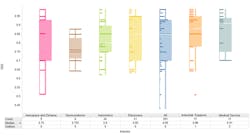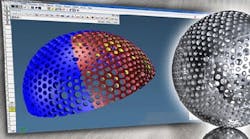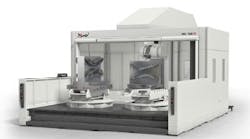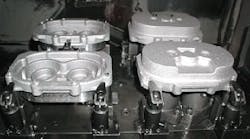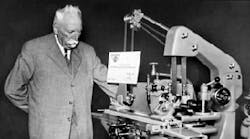Bruce Cain is trying to save his livelihood. He's pleaded with Congressmen and Senators, testifiedat hearings and commissions in Washington D.C., and joined every possible organization and coalition to make his voice heard. He's not looking for a handout, but just a chance to compete for work on a level international playing field.
As the president of Excel Mold and Machine Inc. in North Canton, Ohio, Cain is no slacker and has done his part on the homefront to keep the mold shop competitive — from re-organizing hospitalization benefits to investing in the latest machine tool technology. But it hasn't been enough, and Excel, like a lot of other U.S shops, keeps losing work because of unfair, predatory trade practices from foreign countries.
"I'm not against free trade when it's fair trade," says Cain. "But the situation with China, for instance, is not free or fair."
That country, according to Frank Vargo, vice president for international economic affairs at the National Association of Manufacturers (NAM), has spent over $200 billion in the past year buying U.S. dollars to keep the Chinese yuan's value down. Its worth remains the same as it was in 1994, and estimates state it is undervalued as much as 40%, giving China an artificial advantage.
NAM continues pressuring the current administration to force China to revalue its currency and let it float. However, the U.S. can't control the yuan because China is a sovereign nation. So what can be done?
Vargo says the U.S. must issue an official determination that China is manipulating its currency, allow the International Monetary Fund (IMF) to police the action, and cite China in violation of IMF requirements. Once that happens, the World Trade Organization (WTO) can charge China with impairing and nullifying its negotiated trade agreements under the Nullification and Impairment agreement.
In early May, 2005, the Bush administration warned China that its currency policies are having a "highly distortionary" impact on global trade. There were also hints of possible economic sanctions, but the Treasury Department failed to declare China a manipulative trading partner.
U.S. Senators Charles Schumer (D, N.Y.) and Lindsey Graham (R, S.C.), on the other hand, advocate a more aggressive approach. They've introduced a bipartisan bill that basically threatens China to revalue its currency or face across-theboard tariffs on its products coming into the U.S.
If passed, the bill provides 180 days of negotiations between the U.S. and China. After that, the U.S. would impose a 27.5% tariff, roughly the midpoint between the 15% and 40% estimates of how much the yuan is undervalued. But if the President sees that China is making an effort to revalue, he could postpone the tariff up to an additional year.
Excel is all for this. "Make China float its currency," says Cain. "And if I quote a job within a few thousand dollars of a Chinese shop, I will win the work. We've found ways to get jobs done fast and inexpensively, and often our prices are lower if the costs of shipping from China are included."
Last year, the U.S. trade deficit reached a reported $487 billion, with well over half of that from Asia. NAM says the reason is currency manipulation.
Japan and other countries intervene with their currencies, but not to the degree China does. The U.S. Treasury can buy an offending country's currency to offset unfair adjustments, but with China, there's no market. The Central Bank of China sets the exchange rate, and that's it.
But Cain's headaches don't stop at the currency issue. He still faces other trade barriers in the form of tariffs, customsclearance requirements, and standards when doing work overseas.
If Excel builds a mold and ships it to China, for instance, the shop pays a 12% tariff and about a 17% value-added tax. Shipping a mold made in China to the U.S., on the other hand, involves only a 3.31% tariff.
According to NAM, most developing countries impose high trade barriers, while industrial ones, are for the most part, not as bad. Approximately 70% of imported goods to the U.S. enter duty-free, while countries such as India and Korea impose tariffs ranging from 10% to 40% against U.S. goods.
Also, customs- clearance requirements add to the hassle and cost. One example is duty-uplift. In this practice, a country does not accept invoice value and ups it to charge a higher duty.
"I'm not against free trade when it's fair trade, but the situation with China, for instance, is not free or fair."
Bruce Cain, president of Excel Mold and Machine
Making matters worse, Asian countries don't accept U.S. standards or test results. U.S. manufacturers must submit their products, along with engineering drawings, for disassembly and inspection if they wish to sell in those countries. This opens the floodgates to a lot of technology counterfeiting, especially prevalent in China because, according to NAM, that country is not meeting its negotiated obligations, one of which is protecting intellectual properties. "The Chinese government, under the WTO, must provide 'effective protection' for intellectual properties," explains Vargo, "but it has yet to do so."
NAM continues its pressure on the U.S. Trade representative to develop a WTO case against China, but to date, that office has not done so. Mainly because it can't get enough American companies doing business in China to come forward with evidence. Most are afraid of retaliation from the Chinese government.
NAM worked to get China into the WTO to reduce trade barriers, and the market is opening up. " The problem," says Vargo, " is U. S. companies are not taking enough advantage of it." This is why NAM has been pressuring the U.S. Department of Commerce to develop an export promotion program that would send U. S. companies to China and establish American trading companies in that country.
Unfortunately, none of these approaches is going to stop the predatory trade practices of the Chinese, comments Alan Tonelson, research fellow with the United States Business and Industry Council (USBIC). He says the solution is not the WTO, but legislation with some "teeth" that spells out clear consequences for China if it fails to move on either its currency-exchange rate or unfair trade barriers. China is acting on some trade barriers, but it can replace them with new ones so fast that the U.S. can't keep up. "You stop one, and another pops up," says Tonelson, "so going after Chinese trade barriers piecemeal is practically pointless."
USBIC champions that the only way to put U.S.China/world trade on a sustainable track is to focus on what the U.S. government can hope to control, which is access to its market. The Chinese desperately need to export to the U.S., which gives the U.S. enormous leverage it should use, explains Tonelson. "The U.S. has to stop relying on trade policies to achieve foreign policies."
As early as the end of the Cold War, he says, the U.S. didn't focus its trade policies on enough longterm economic interests. Instead it granted trade concessions (wide-open access to the U.S. market) and tolerated unequal trade to win or maintain a foreign country's friendship. By the 1990s, the economic damage was done, and only large multinational companies benefited from such trade policies.
These companies still produce in the U.S. and supply work to small shops. "But one has to ask," queries Tonelson, "how have their ratios of global procurement from U.S. and non-American sources changed since the 1990s?"
Cain has a good idea how the ratio has changed, and it wasn't in his mold shop's favor. His biggest customers are now shipping large portions of work (that Excel used to get) overseas, mostly to China and Korea. Cain estimates he's lost about $15 million worth of work. And most of the time the shop doesn't even get to quote on jobs because they go directly overseas.
"The U.S. has to stop relying on trade policies to achieve foreign policies."
Alan Tonelson, United States Business and Industry Council (USBIC)
"Fellow shopowners tell me they might as well be getting no work than the measly amount they are," says Cain. This just-put-me-out-ofmymisery feeling convinces Cain that an uneven international playing field has crippled U.S. manufacturing, but he refuses to go down without a fight.
In addition to joining national associations and lobbying groups, he's part of a grassroots coalition called North East Ohio Campaign for American Manufacturing (NEOCAM). The group is the voice of small, mostly family-owned U.S.based firms, but it doesn't go to Washington D.C. Instead, it lobbies those returning home, dispersing the message that old economic models are no longer relevant to today's U.S.-trade problems.
"We don't need any more agreements modeled after the North American Trade Agreement (NAFTA), which cost Ohio alone nearly 50,000 jobs," says John Colm, secretary treasurer of NEOCAM. "Such agreements with miniscule economies increase the flight of international capital (machinery and investing) to countries where labor is cheap and plentiful." Like Cain, NEOCAM isn't against free trade, as long as it focuses on the U.S.'s best interests. But according to AMT — The Association of Manufacturing Technology, a built-in lobby within U.S. industry wants to keep the playing field the way it is because, quite frankly, China holds down production costs for U.S. companies. However, the U.S. is digging itself into a hole and destroying domestic jobs when its companies rush to take advantage of an artificial currency. China is an export-led economy, says Tonelson, with modest consumption due to extremely low wages. In addition, typical Chinese workers save about 40% of their incomes out of fear. They've lived through the country's turbulent past and are uncertain about its volatile future. Supporting this export-growth strategy is why China keeps its currency pegged.
There are too many people chasing too few jobs in China, he adds, and the country must keep its population working even though its market can't absorb all the goods they produce. So it exports the surplus and continues to produce to control the jobless problem — in urban areas, unemployment exceeds 20%.
"We don't need any more agreements modeled after the North American Trade Agreement (NAFTA), which cost Ohio alone nearly 50,000 jobs. "
John Colm, North East Ohio Campaign for American Manufacturing (NEOCAM)
If the playing field were level, some U.S. companies couldn't compete with China, but on the same token, certain Chinese firms would be unable to compete with U.S. ones. The reason is that, while the U.S. labor rate is high, the country has a capital base that China doesn't.
Tonelson predicts " big multinational companies, which are enamored with boosting short-term profits by using factories in low-wage countries to supply their U.S. customers, will continue to support new trade agreements that make such outsourcing easy." While on the other hand, he says small domestically focused manufacturers that rely on selling to these large firms will suffer under such trade agreements.
Cain hopes the U.S. government soon realizes how detrimental an unfair international playing field is on U.S. companies like his and acts accordingly. But he isn't holding his breath. So in the meantime, he's going to continue to tell anyone who will listen about the severity of this situation.
NAM projects a positive outlook. China will concede and do the right thing for two reasons. The first is that China knows if the problems reach critical mass the U.S. may take a protectionist stance, which wouldn't be good for either country. And the second is China lacks the capability to continue adding to its dollar reserves for maintaining the yuan.
Success in China
U.S. machine tool builder Haas Automation doesn't manufacture in China, but successfully sells in that market and has been doing so for almost 10 yr. Its strategy is no big secret.
"The only effective way to do business in China is to be there," says John Roth, who provides sales support to the company's China office. Through Haas Automation China, the builder employs its factory-outlet concept that hinges on having machines readily available and providing after-sales support.
At first attempt, this Haas-philosophy transfer to China didn't fly because the company worked with Chinese distributors from its Oxnard, Calif., manufacturing plant. Pricing was sketchy, service spotty, machines got hung up in customs, and documentation was confusing.
Currently, the company has five distributors located in specific geographic protected territories, 30 employees at its office in Shanghai, and a director of China operations who has been with the company for 15 years. His job is "exporting" the Haas culture to the Chinese staff and distributor network.
The Chinese facility is as wellstocked with machines, spare parts, and technical/service personnel as the company's U.S. operations. Chinese customers know upfront what a machine costs, how long delivery will take, and that there is local after-sales support for it. Having personnel in country, Haas easily navigates through Chinese laws and better understands its culture.
As far as trade barriers are concerned, Roth says he doesn't view the Chinese as all that unfair. "We're paying higher tariffs in India and Brazil," he comments.
But is Haas afraid of intellectual-property piracy? It would appear not. The company notes there exists several Haas knock-offs from Taiwan, but those builders have yet to duplicate Haas' in-house-made controls or its after-sales support network.
"The only effective way to do business in China is to be there."
John Roth, Haas Automation
